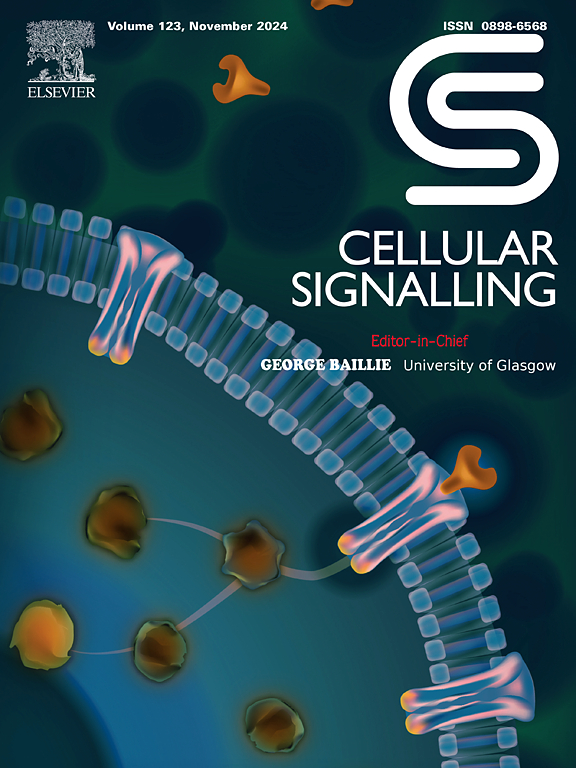METRNL exerts cytoprotective effects on EPCs via regulation of the E2F1-TXNIP axis in obese limb ischemia
IF 4.4
2区 生物学
Q2 CELL BIOLOGY
引用次数: 0
Abstract
Background
Obesity increases cardiovascular disease risk by impairing angiogenesis, primarily through dysfunction of endothelial progenitor cells (EPCs). METRNL, a recently identified secreted protein, exhibits diverse biological activities. However, its impact on EPC function and its role in obesity-related microvascular dysfunction remain unclear. This study aims to investigate the effects of METRNL on EPC function and its potential therapeutic mechanisms for promoting angiogenesis.
Method
In vitro, human EPCs derived from peripheral and umbilical cord blood were treated with recombinant METRNL protein (rMETRNL) and exposed to palmitic acid (PA). EPC proliferation, migration, and tube formation were assessed. Apoptosis and pyroptosis levels were evaluated using Western blotting, flow cytometry, scanning electron microscopy (SEM), immunofluorescence (IF), and enzyme-linked immunosorbent assay (ELISA). RNA sequencing, ChIP, and dual-luciferase assays were performed to investigate the regulatory mechanisms. In vivo, an obese mouse model with hind limb ischemia received local injections of METRNL-overexpressing EPCs in the ischemic muscle. Blood flow recovery was monitored using laser Doppler flowmetry and CD31 immunofluorescence.
Results
Replenishment of METNRL alleviated PA-induced apoptosis and pyroptosis of EPCs, while simultaneously enhancing their proliferation, migration, and tube formation. Mechanistically, RNA sequencing revealed that rMETRNL restoration downregulated E2F1 expression, and the protective effects of METRNL were partially reversed by E2F1 overexpression. Further, E2F1 was found to bind the TXNIP promoter region, promoting TXNIP transcription. Elevated TXNIP levels counteracted the beneficial effects of rMETRNL on EPC function in the presence of PA. In vivo, the transplantation of METRNL-overexpressing EPCs into the ischemic hind limbs of obese mice promoted angiogenesis, as evidenced by improved blood flow recovery and increased CD31 immunofluorescence in the ischemic tissues.
Conclusion
Our research emphasizes the potential of METRNL in reducing EPC cellular pyroptosis and promoting angiogenesis by inhibiting the E2F1-TXNIP signaling pathway. METRNL shows promise in treating obesity-related cardiovascular diseases through angiogenic therapy.

METRNL通过调节E2F1-TXNIP轴对肥胖肢体缺血中的EPC发挥细胞保护作用。
背景:肥胖主要通过内皮祖细胞(EPCs)功能障碍损害血管生成,从而增加心血管疾病风险。METRNL是最近发现的一种分泌蛋白,具有多种生物活性。然而,它对 EPC 功能的影响及其在与肥胖相关的微血管功能障碍中的作用仍不清楚。本研究旨在探讨METRNL对EPC功能的影响及其促进血管生成的潜在治疗机制:方法:在体外,用重组 METRNL 蛋白(rMETRNL)处理来源于外周血和脐带血的人 EPCs,并将其暴露于棕榈酸(PA)中。对 EPC 的增殖、迁移和管形成进行了评估。使用 Western 印迹、流式细胞术、扫描电子显微镜 (SEM)、免疫荧光 (IF) 和酶联免疫吸附试验 (ELISA) 评估凋亡和热凋亡水平。为了研究调控机制,还进行了 RNA 测序、ChIP 和双荧光素酶测定。在体内,肥胖小鼠后肢缺血模型的缺血肌肉局部注射了过表达 METRNL 的 EPCs。使用激光多普勒血流测量仪和 CD31 免疫荧光法监测血流恢复情况:结果:METNRL的补充缓解了PA诱导的EPCs凋亡和热凋亡,同时增强了它们的增殖、迁移和管形成。从机理上讲,RNA测序显示,rMETRNL的恢复会下调E2F1的表达,而E2F1的过表达会部分逆转METRNL的保护作用。此外,还发现 E2F1 与 TXNIP 启动子区域结合,促进 TXNIP 的转录。在 PA 存在的情况下,TXNIP 水平的升高抵消了 rMETRNL 对 EPC 功能的有益影响。在体内,将过表达METRNL的EPC移植到肥胖小鼠缺血的后肢可促进血管生成,缺血组织中血流恢复的改善和CD31免疫荧光的增加都证明了这一点:我们的研究强调了 METRNL 通过抑制 E2F1-TXNIP 信号通路减少 EPC 细胞凋亡和促进血管生成的潜力。METRNL有望通过血管生成疗法治疗与肥胖相关的心血管疾病。
本文章由计算机程序翻译,如有差异,请以英文原文为准。
求助全文
约1分钟内获得全文
求助全文
来源期刊

Cellular signalling
生物-细胞生物学
CiteScore
8.40
自引率
0.00%
发文量
250
审稿时长
27 days
期刊介绍:
Cellular Signalling publishes original research describing fundamental and clinical findings on the mechanisms, actions and structural components of cellular signalling systems in vitro and in vivo.
Cellular Signalling aims at full length research papers defining signalling systems ranging from microorganisms to cells, tissues and higher organisms.
 求助内容:
求助内容: 应助结果提醒方式:
应助结果提醒方式:


